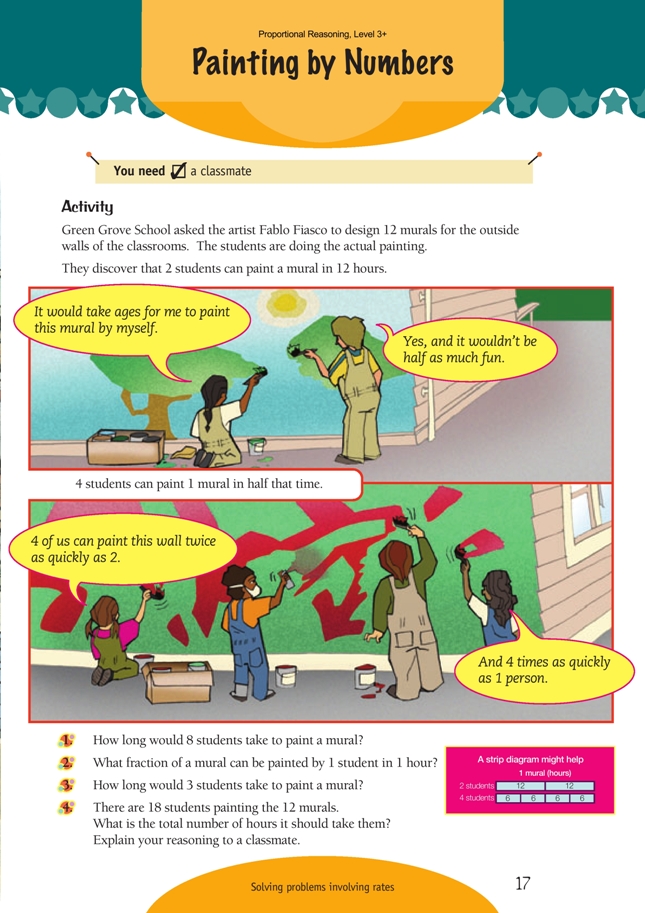This is a level 5 number activity from the Figure It Out series. It relates to Stage 8 of the Number Framework.
A PDF of the student activity is included.
Click on the image to enlarge it. Click again to close. Download PDF (1064 KB)
solve inverse proportion problems
Number Framework Links
Use this activity to introduce students to the concept of inverse proportion (stages 7 and 8).
A classmate
This activity introduces students to inverse proportion. This is the kind of relationship that exists between two quantities when an increase in one means a decrease in the other. Students know without being told that such relationships exist, and when you introduce this activity, you could begin by drawing out that knowledge.
Examples of inverse relationships include: the more fully the taps are turned on, the less time it takes to fill the bath; the faster you bike, the shorter the journey; the slower you type, the longer the document takes; the more expensive an item, the fewer you can buy; the bigger the files, the fewer that will fit on a disk; the thicker you apply the paint, the smaller the area you can cover.
An important idea about inverse relationships is that they can only exist when they relate to a third thing that is fixed in size or quantity: a bath to be filled, a journey to be completed, a document to be typed, an amount of money to be spent, a disk to be filled, a can of paint to be applied. If you had an endless supply of money, the relationship between cost and number would no longer be an inverse one: you could buy as much or as many of something as you wanted, no matter what the cost.
The dialogue in the student book provides an excellent starting point for class discussion: there is a job to be done (this is the thing that is “fixed in size or quantity”) and the more people who help (within the limitations of common sense), the faster the task will be completed. The dialogue gives examples of how the ratio works but doesn’t model how to to write it down. Students could start with a table like this:
The table answers question 1 and, if a line is added at the top, can provide the answer to question 2. If your students are familiar with ratio notation, you could get them to use it to describe the student:hours ratios. Emphasise that the ratios 2:12, 4:6, and 8:3, though connected, are not the same, so they must not have “=” signs placed between them. 2:12 → 4:6 → 8:3 is an acceptable way of linking the ratios and can be read “2:12 leads to the ratio 4:6, which leads to the ratio 8:3.”
Students can solve question 3 by using the 1:24 ratio that they arrived at for question 2. As they are interested in how long the job would take 3 student painters, they should multiply the 1 by 3 and divide the 24 by 3. Therefore, 3 painters would take 8 hours. Discuss whether it is a coincidence that 3 painters take 8 hours while 8 painters take 3 hours. It’s not. It is important that students realise that inverse ratios always work in pairs like this: if a ratio is true for a given situation, when the two numbers are reversed that (different) ratio is also true. Students might notice that for all the inverse ratio pairs in this activity, the product of the two numbers is 24. This is not a coincidence either: 24 is the number of student hours 1 mural will take.
You should give your students every opportunity to solve question 4 by themselves or in small groups. As long as they have begun to think multiplicatively, they will have a number of different strategies they can use. They should share these with a classmate and with the group. Here are three possible strategies:
1. Divide the 18 students into 6 groups of 3 and set them all to work. This means that each group must paint 2 murals (6 x 2 = 12). We know from question 3 that it will take 3 students 8 hours to paint 1 mural, so it will take each group 16 hours (twice as long) to paint both their murals. So the 18 students will take 16 hours to paint 12 murals.
2. Using our answer from question 2, we know that it would take 1 student 24 hours to paint a mural. So 18 students would paint a mural in 24 ÷ 18 = 1 hours. This means that it will take 1 x 12 = 16 hours for them to paint 12 murals.
3. If 18 students are painting 12 murals, that means that 3 students will be responsible for 2 murals. It takes 2 x 24 = 48 hours to paint 2 murals, so if 3 are sharing the work, it will take them 48 ÷ 3 = 16 hours.
Answers to Activity
1. 3 hrs. 2 students take 12 hrs, so 4 students would take 6 hrs and 8 students would take 3 hrs. (Doubling and halving)
2. 1/24 of the mural
3. 8 hrs. (24 ÷ 3 = 8)
4. 16 hrs. (There are many ways of working this out. Here is one:
If 18 students are painting 12 murals, in groups of 3 students, each group has to paint 2 murals. It takes 24 x 2 = 48 student hrs to paint 2 murals. This means that it will take 48 ÷ 3 = 16 hrs for all the students to paint all the murals.)

